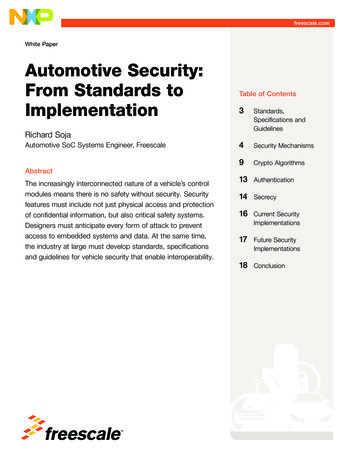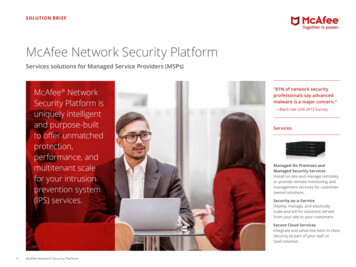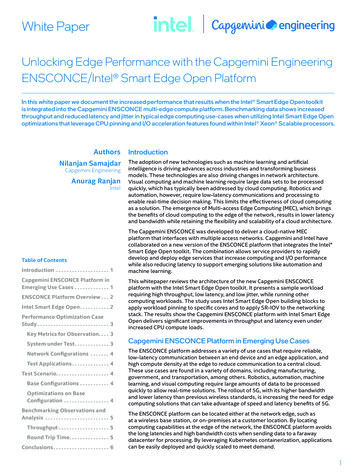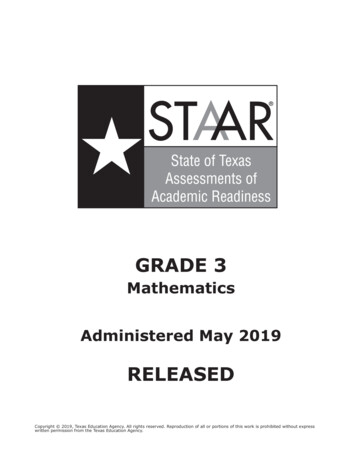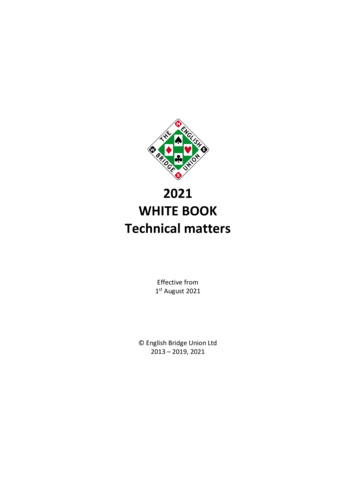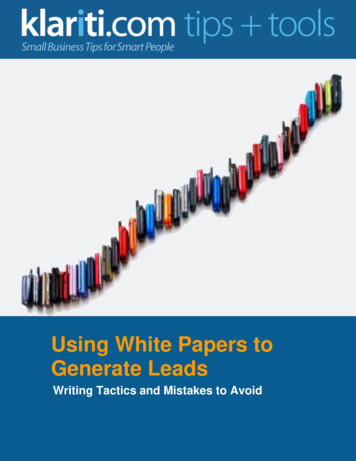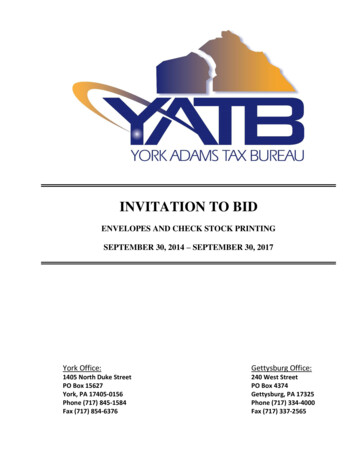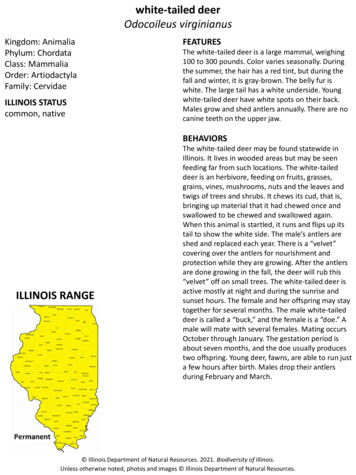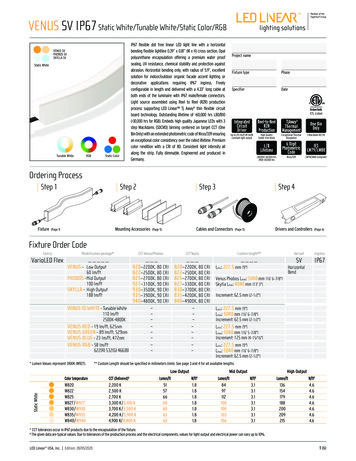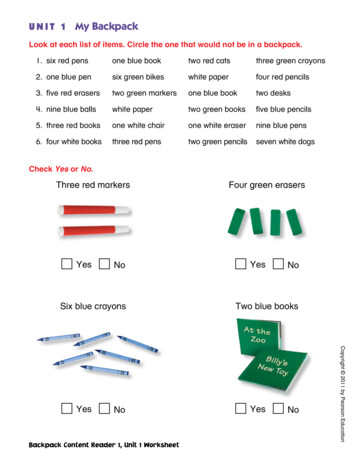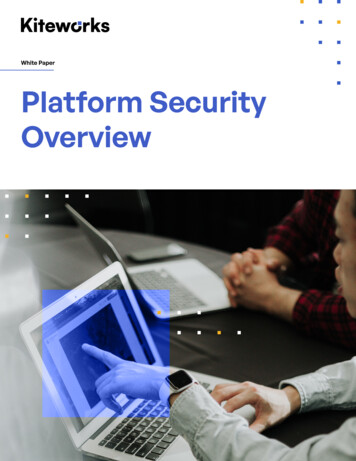
Transcription
White PaperPlatform SecurityOverviewwww.kiteworks.com
White PaperPlatform Security OverviewWhy Kiteworks?There’s a reason why more than 3,800 leading enterprises and government agencies trustKiteworks with their external file sharing and data governance needs, and why 25 millionusers have used Kiteworks solutions when sharing confidential information with colleagues,partners, and vendors across organizations and devices.The reason is enterprise-grade security.Enterprise data security is a top priority for leading enterprises and government agencies. Kiteworks’ leadingexternal secure file sharing solution is built for security from the ground up.In fact, at Kiteworks, security drives not just the design of our solutions but also the design of all our processes andprocedures.This document provides an overview of the security features in and capabilities of our secure file sharing platform thatprovides your organization with full visibility and control of your most sensitive enterprise data as its shared externally.Architecture of Deep DefenseHow do you ensure that your data is always secure, confidential, accurate, reliable, available,and under your control?You use a defense-in-depth solution that applies a military strategy to secure your systemsand your data.The design principle behind Kiteworks’ secure file sharing platform is a military layering tactic. We use severalindependent methods and multiple layers of defense to protect the content management systems and businessapplications we integrate with from attack—methods such as protection against espionage and direct attacks, aswell as methods that reduce and mitigate the consequences of a security breach by buying the organization timeto detect and respond to an attack.Our platform enforces security at every level, starting at the network level and going deeper into the applicationand data levels. We also build security into our software development and product management processes.The first level of security is provided at the network level. Kiteworks’ network topology is designed to reduce anorganization’s attack surface and provide protection from outside threats. For on-premise deployments, only theweb layer is exposed in the DMZ. All server-to-server communication is encrypted with automated key rotation,and all server-to-client-device communications use SSL/TLS. Web services can be separated from end-user databy IT administrators so that user files and metadata are hosted behind your corporate firewall. Only necessaryservices are kept running and only required ports are kept open.2
White PaperPlatform Security OverviewEach tier can be scaled independently to add load balancing and redundancy as needed.The three key benefits of Kiteworks' multi-tier architecture are: Reduced attack surface Data integrity High scalability and availabilityKiteworks architectureDeeper security is embedded in the application level through security settings that are designed to ensure dataintegrity. We provide account access and configurable authentication security, integrated SSO and LDAP/AD,embedded antivirus, and integrations with data leak prevention and advanced threat prevention software. Auditlogs can be sorted by attribute and exported for audits and legal requests.Still deeper security is provided at the data level through encryption of data in transit and data at rest. Our dataencryption module is FIPS 140-2 certified.And at the deepest process level, we offer one-click software updates to keep system libraries up to date and toprovide security patches on a priority basis.Kiteworks conducts full penetration and code reviews for all products once a year using an external party. Inaddition, we run another penetration test every six months and enable customers to perform their own penetrationtests at any time.We adhere to OWASP coding practices and use off-the-shelf tools such as Burp Suite that are built aroundthe OWASP model, as well as internally created tools for QA and penetration testing for every release. We runautomation scripts and unit tests before every release to ensure product stability.Our products also undergo regular third-party security audits.3
White PaperPlatform Security OverviewFirst Line of Defense: Network SecurityNetwork topology is the key to creating secure networks. Kiteworks offers five secure deployment options: OnPremises Private Cloud, Customer Hosted IaaS, Kiteworks Hosted Private Cloud, Hosted FedRAMP, and HybridPrivate Cloud.On-premise Private Cloud DeploymentThis type of deployment is done on your premises, using a VMware or Hyper-V virtual machine. On-premiseenvironments offer the highest levels of security and control as they enable the enterprise to keep servers,storage, application service, metadata, and authentication within the organization’s firewall. Most securityconscious organizations tend to prefer an on-premise deployment.On-premise deployments that are 100% on premises create a private cloud environment in the company’s datacenter for a single-tenant dedicated instance that prevents any co-mingling of data. Furthermore, the organizationitself controls the encryption keys; Kiteworks does not have any access to customer data.Customer Hosted IaaS DeploymentCustomers who want to deploy Kiteworks on their AWS or Azure resources can deploy it in the same way theywould on their VMware or Hyper-V systems on premises.Kiteworks Hosted Private Cloud DeploymentThis type of deployment is hosted by Kiteworks, using Microsoft Azure or Amazon Web Services (AWS) EC2.Hosted deployments enable enterprises to rapidly implement secure file sharing, quickly scale resources andteams, and manage peaks in usage.The hosted private cloud deployment provides a dedicated instance with no co-mingling of data. It gives thecustomer full control of application policies and system settings.Microsoft AzureMicrosoft Azure is a public cloud service platform that supports a broad selection of operating systems,programming languages, frameworks, tools, databases, and devices. Azure’s infrastructure is designed from thefacility to applications for hosting millions of customers simultaneously, and it provides a trustworthy foundationupon which businesses can meet their security needs. In addition, Azure provides organizations with a wide arrayof configurable security options and the ability to control them so that you can customize security to meet theunique requirements of your deployments to meet your IT control policies and adhere to external regulations.These include: CDSA, CJIS, DFARS, EU-US Privacy Shield, FedRAMP, FERPA, FIPS 140-2, HITRUST, ISO 27001, ITAR,NIST 800-171, PCI DSS, SOC 1-3, and many more.4
White PaperPlatform Security OverviewAWSAmazon Web Services (AWS) delivers a scalable cloud computing platform with high availability and dependability,providing the tools that enable customers to run a wide range of applications. AWS is responsible for protecting theglobal infrastructure that runs all of the services offered in the AWS cloud. This infrastructure, which is comprisedof the hardware, software, networking, and facilities that run AWS services, is designed and managed according tosecurity best practices as well as a variety of security compliance standards. AWS customers can be assured thatthey are building web architectures on top of some of the most secure computing infrastructure in the world. The ITinfrastructure that AWS provides to its customers is designed and managed in alignment with security best practicesand a variety of IT security standards, including: SOC 1-3, FISMA, DIACAP, FedRAMP, PCI DSS Level 1, ISO 27001, ITAR,FIPS 140-2 and others. In addition, the flexibility and control that the AWS platform provides allows customers todeploy solutions that meet several industry-specific standards, including: CJIS, CSA, FERPA, HIPAA, and more.Hosted FedRAMP DeploymentKiteworks' FedRAMP authorized solution for moderate impact data is available to Government agencies andcommercial businesses in isolated environments on Amazon Cloud.This deployment option is ideal for organizations that require the highest level of security or are required by theFederal Government to have a compliant security plan for sharing data. Compliance with ITAR is one such example.FedRAMP authorization requires an extensive application process involving thorough documentation of Kiteworks'security processes, assessments of related systems, creation of a System Security Plan, and training andcertification of Kiteworks employees who have access to the FedRAMP environment—over 400 controls in total.Kiteworks has assembled a team of security and IT experts to support FedRAMP customers and, per FedRAMPrequirements, this team is comprised of U.S. citizens, based within the United States.In order to retain FedRAMP Authorization status, Kiteworks undergoes continuous monitoring, vulnerabilityscanning, and annual audits of our controls. These audits are performed by a Third Party Assessment Organization(3PAO), which is also FedRAMP authorized.Hybrid DeploymentKiteworks also offers an on-premise and hosted hybrid private cloud deployment. Hybrid deployments are ideal forcapacity planning and for supporting remote offices (offices that are not close to a company’s data center).The hybrid deployment mixes on-premise servers and hosted servers for selected roles (such as storage) andEnterprise Connect applications (such as SharePoint), separated by firewall from the hosted private clouddeployment that delivers a single tenant environment.Geographical Segregation and Data SovereigntyKiteworks enables IT administrators to set up rules restricting data movement across data centers and geographicalregions. For example, they can specify that all files uploaded by users in a particular country or geographical regionstay in that region, thus allowing for separation of data and complying with data sovereignty regulations.5
White PaperPlatform Security OverviewAchieving Data Sovereignty With KiteworksSupport for Disabling TLS 1.0 and 1.1Because of security concerns with older versions of TLS, Kiteworks allows administrators to disable TLS 1.0 and 1.1,ensuring that traffic is transmitted securely over TLS 1.2.Second Line of Defense: Application SecurityKiteworks provides an extensive suite of account access and authentication policy management featuresthat can be customized to meet your business requirements. Many of the features are configurable by your ITadministrators. Your enterprise can determine the level of control that needs to be exercised for corporate fileaccess and tracking.Account Access and AuthenticationKiteworks provides comprehensive and flexible sign-in and authentication management tools.Sign-inKiteworks uses OAuth authentication for user sign-in to the server. Users are required to enter their user name andpassword. Upon successful authentication, the application retrieves an access token from the server that is usedin further communications with the server during the session.6
White PaperPlatform Security OverviewAuthenticationKiteworks provides configurable authentication policies for password, files, data, and URL calls:Password strength policy. Configure password requirements, such as the minimum number of characters, numberof numeric character(s) between 0 and 9, number of special characters, and number of upper- and lowercasecharacters required for passwords.Password Expiration policy. Configure time period for active/working passwords.Password History policy. IT administrators can set a policy to allow or disallow the re-use of passwords by users.Account lockout policy. Configure number of wrong sign-in attempts before lockout.Data access policy. Select option to restrict data access to authenticated users who have been granted access tothe content.Single Sign-on and LDAP integrationFor enterprise accounts, Kiteworks provides your IT administrators with the ability to centralize user accountcontrol and management using the following features: Active Directory/multi-LDAP/LDAPS SAML 2.0 and Kerberos integration to support single sign-on and information exchange betweendifferent security domains.Two-factor AuthenticationFor enterprises that use 2FA, Kiteworks leverages the industry standard RADIUS protocol to integrate with thecustomer’s 2FA solution.2FA for Kiteworks can be integrated with any server using the RADIUS protocol. Kiteworks passes the user’sauthentication credentials over RADIUS protocol to the 2FA RADIUS server. The server’s response determines ifthe user can sign in or not.Kiteworks guides customers in choosing the authentication flow that is appropriate and required for their 2FAsolution. Kiteworks has a one-time password option that administrators can enable for occasions when externalusers don’t have access to an enterprise’s internal RADIUS system.Pre-authentication Redirect Login FlowKiteworks enables IT administrators to implement an alternative login flow for users of single sign-on (SSO)services, including SSO services that work with Personal Identity Verification (PIV) and Common Access Card(CAC) cards, which are mandated by several U.S. government agencies. When this alternative login flow is enabled,Kiteworks prompts users for a username or email address before displaying a password field. Once the usernameor email address is entered, Kiteworks takes one of two actions. If the user is registered with an SSO service,Kiteworks automatically redirects the user to the organization’s SSO identity provider, so the user can enter his/her password for the SSO service. If the user is not an SSO user, Kiteworks displays the standard password field forthe user’s Kiteworks account.7
White PaperPlatform Security OverviewPassword History PolicyIT administrators can set a policy to allow or disallow the re-use of passwords by users.AntivirusAntivirus software is integrated within Kiteworks to scan files being uploaded to any Enterprise ContentManagement (ECM) system connected to Kiteworks or to Kiteworks itself. If a file containing a virus is found,Kiteworks immediately quarantines the file and prevents it from being uploaded. The antivirus service can beenabled or disabled by IT administrators. Kiteworks uses F-secure antivirus software for multi-device Internetsecurity for PC, Mac, smartphone, and tablet.Advanced Threat Prevention, Including Zero-day AttacksLeveraging integrations with leading Advanced Threat Prevention (ATP) solutions, Kiteworks provides organizationsan integrated governance framework over all of the content entering or leaving the organization to prevent malwarefrom infiltrating the organization’s network. Granular visibility and control of content going through the Kiteworksplatform enables organizations to analyze and either block or simply report on any threats of malicious datadetected by the ATP solution.Data Loss PreventionIT administrators can integrate Kiteworks with popular Data Loss Prevention (DLP) systems that support theInternet Content Adaptation Protocol (ICAP) such as Forcepoint, Trend Micro, Symantec, Fidelis, PalisadeSystems, and Digital Guardian.8
White PaperPlatform Security OverviewOnce integrated, Kiteworks can be configured to run a DLP scan on any file downloaded from a connected ECMsystem or uploaded to a cloud based content system to ensure that no data privacy policies are being violated.If a file violates the DLP policies, it is marked as non-compliant and put into quarantine to prevent it frombeing downloaded, uploaded or shared. Both the sender and recipient are notified of the quarantine. Only ITadministrators can remove a file from quarantine. By supporting DLP scans, Kiteworks helps prevent PersonallyIdentifiable Information (PII) and other sensitive data from being inadvertently leaked.DLP for Kiteworks is a licensed feature.Folder PermissionsKiteworks provides robust yet flexible folder permission management features to enable your IT administrators tocontrol access to enterprise content across the organization.The following folder permissions management features are available: File Tracking. Folder Owners, Managers, and Collaborators can view activity logs to see who has accessed afolder, and downloaded/uploaded/edited/deleted files, and added comments. Notifications. Folder Owners, Managers, Collaborators, and Downloaders can subscribe to receive e-mailalerts when files or comments are added by members, i.e., anyone with access to a folder. Secure Links. Folder Owners, Managers, and Collaborators can share files securely by sending recipients asecure link to their files. Collaboration. Folder Owners and Managers can manage users and internal and external stakeholderswho have access permissions to their secure folders by assigning them user roles depending on businessrequirements. Online Viewer. Viewers can view documents within the browser or Mobile App without being grantedpermission to download them. This feature increases not only user productivity but also data security since itdoes not store local copies of documents on endpoints.Desktop File SynchronizationKiteworks provides robust, secure, and flexible file synchronization. Your IT administrators can enable continuoussync, on-demand sync, or scheduled sync. Once folder sync has been enabled, users with Manager privileges canenable or disable sync for individual folders.Kiteworks file synchronization security features include: Authenticating Kiteworks desktop client sessions through OAuth. Authenticating end-users to the Kiteworks desktop client through LDAP/AD, SAML, and Kerberos. Enabling IT administrators to view Kiteworks activity logs and track files that are being synchronized. Set the desktop clients to encrypt the synced data and lock the sync folder when not in use. Remote wipe for desktop clients.9
White PaperPlatform Security OverviewMobile Push and Mobile SyncData is protected with encrypted containers that can be remotely wiped by an IT administrator should a mobiledevice be lost or stolen or the device owner leaves the organization.Audit TrailKiteworks automatically logs all file and user activities in the application. The audit log provides your ITadministrators full insight into system activities, user activities, file activities, and overall system health. Audittrails and comprehensive file tracking help enterprise organizations demonstrate compliance with internal policiesand government regulations. Audit logs are date/time stamped and tracked by user, email address, IP address, andaction taken. IT administrators can sort by these attributes and also export the audit log either as a CSV file or to aSyslog server. Finally, your IT administrator determines how long logs are stored on the platform.Advanced Governance and eDiscoveryFor internal investigations and eDiscovery efforts, Kiteworks offers a Data Leak Investigator role. The DLI is able torun reports on individual users, download files accessed by those users, and download all emails sent to or fromthose users via Kiteworks. The DLI role can also be exposed using our enterprise APIs to integrate Kiteworks withyour existing eDiscovery tools.eDiscovery for Kiteworks is a licensed feature.FIPS 140-2Kiteworks uses a FIPS 140-2 Level 1 certified module for secure file sharing for both on-premise and hosted clouddeployments. Data in transit is encrypted with FIPS-certified cipher suites and cryptographic algorithms.FIPS support for Kiteworks is a licensed feature.ComplianceKiteworks enables compliance with industry and government regulations, including GDPR, SOX, HIPAA (with signedBAA), ITAR, SOC2 and SSAE 16 Type 2, and FedRAMP.10
White PaperPlatform Security OverviewThird Line of Defense: Data SecurityKiteworks offers an extremely secure data encryption strategy.EncryptionKiteworks encrypts all content in its system, whether the files are in transit or at rest.Data in transit is secured via an SSL/TLS encrypted connection. Data at rest is encrypted with 256-bit AES encryption.User-friendly Digital Rights Management (DRM)Integrated user-friendly DRM capabilities enhance the protection of documents without sacrificing end-userproductivity. DRM features include a View Only role, custom watermarking, and the ability to withdraw files. View Only Role. Users can only view content within the browser or Mobile App, and cannot download orsynchronize content to their desktop or device. Watermarking. Users can only view an image of the file with a customizable watermark. Watermarks deterunauthorized file sharing via screen capture or hard copy printing. File Withdraw. Users can withdraw previously sent files. Once withdrawn, file links immediately expire,preventing recipients from accessing content.Secure Message Transmission With or Without Email AttachmentsWhen sending email messages, web and Outlook users of Kiteworks have the option of securing the attachment alone,the message body alone, or both. IT administrators have the option of requiring all message bodies to be secured.Fourth Line of Defense: Secure ProcessesUpdatesKiteworks provides periodic updates to keep system libraries up to date.Security ProcessesThe following security processes are followed to ensure major risks are accounted for: Kiteworks runs a bug bounty program to find security vulnerabilities. The bug bounty program is offered bymany websites and software developers by which individuals can receive recognition and compensation forreporting bugs, especially those pertaining to exploits and vulnerabilities. Kiteworks performs developer training on best practices based on OWASP Top 10 and SANS Top 25. The Security team runs security review of all features and only features that pass the review can be released.11
White PaperPlatform Security Overview Kiteworks uses Burp Suite which is an integrated platform for performing security testing of web applications.Burp Suite maps and analyzes periodically and before every release web applications, finding and exploitingvulnerabilities. Kiteworks runs Nessus scans to detect third-party vulnerabilities. Nessus is a remote security scanning tool,which scans a computer and raises an alert if it discovers any vulnerabilities that malicious hackers could useto gain access to any computer you have connected to a network. Kiteworks runs internal white box scans. White box testing is a security testing method that can be used tovalidate whether code implementation follows intended design, to validate implemented security functionality,and to uncover exploitable vulnerabilities. All vulnerabilities found through these different means are classified and rated using CVSSv3. They are thenprioritized for fixing based on a severity rating scale which is used to determine the release dates using astandard scoring system.Security UpdatesRegular security updates are made to mitigate and resolve vulnerabilities. Policy enforcement updates areperformed. Kernel and software updates are made to avoid security risks.Patch ManagementKiteworks rolls out patches on a priority basis. Because the Kiteworks appliance includes the operating system,database server, webserver, and the application, Kiteworks' patches cover all of these pieces. IT administratorsdon’t have to monitor each piece for patch updates or worry about compatibility. The sever monitors for patchesand, when a patch is available, IT administrators apply the patch with one click.Security AuditsKiteworks products undergo regular third-party security audits. For more information, please contact Kiteworks.12
White PaperPlatform Security OverviewMobile Security: Architecture of Special DefenseMobile file sharing is particularly vulnerable to security breaches.Our solution enables secure mobile access to Kiteworks accounts from mobile browsers and Kiteworks MobileApps for iOS and Android.Our solution also provides several configurable options for your IT administrators to centrally manage and controlmobile access to corporate resources. Mobile access can be enabled or disabled and access levels can be set forusers depending on security requirements.Mobile Communication: Securing Mobile NetworksSSL/TLS Network CommunicationOur applications use APIs to communicate with the Kiteworks server. All communications, including downloadsand uploads, are performed using SSL/TLS. Kiteworks Mobile Apps will only accept certificates that have beeninstalled in Trusted Credentials or Configuration Profiles on the device.Secure AuthenticationOur Mobile Apps support authentication through LDAP, ensuring that only authorized users gain access to secure folders.PIN and Touch IDAs with the desktop client, Kiteworks uses OAuth authentication for mobile user sign-in to the server. Usersare required to enter their user name and password on the web browser. Upon successful authentication, theapplication retrieves an access token from the server that is used in further communications with the server. iOSusers have the option of using Touch ID instead of a PIN.During the lifetime of the access token, the user is not required to re-sign in to the Kiteworks Mobile App andsimply enters a six-digit PIN.PIN settings are configurable. IT administrators can choose to require users to enter their PIN every time theyaccess the Kiteworks Mobile App, or after a particular time interval has passed, or while in offline mode. If thecorrect PIN is not entered within the maximum number of tries allowed, all of the previously downloaded data isdeleted from the device, and the user is forced to re-sign in and re-set his/her PIN. Alternatively, IT administratorsalso have the option of not requiring users to enter a PIN.The access token, PIN, and other policies configurable by the IT administrator are securely stored in the MobileApp’s user preferences or keychain.The user has the option to re-set his/her PIN at any time. When the PIN is re-set, the user is required to sign in again.The Mobile App then retrieves the Data Encryption Key (DEK) from the server and locally re-encrypts the DEK using anew key based on the new PIN. Locally stored files remain encrypted. Resetting the PIN only affects the local GateKey,which is used to encrypt the DEK. Every time the PIN is reset, the DEK is re-calculated and re-encrypted with the newGateKey. Local files however never change because the DEK never changes.13
White PaperPlatform Security OverviewMobile Data Encryption: Securing Mobile DataAll access from a mobile device to the Kiteworks server uses HTTPS channels and OAuth authentication.Users are required to enter a six-digit passphrase when they access encrypted files downloaded to the mobiledevice through Kiteworks Mobile Apps.Files are stored in a secure container with 256-bit AES encryption while at rest. Files shared with others via e-mailare sent via the SSL/TLS protocol.The Kiteworks Mobile App for iOS uses the iOS keychain wrapper and AES-256. The Kiteworks Mobile App forAndroid also uses AES-256.The Mobile App will perform its own encryption of user names, passwords, and other sensitive data into the iOSkeychain wrapper, which is a secure wrapper included in the iOS. This prevents other applications from accessingthe data by using the certificate that was used to sign into the app as a key for the keychain.All file data downloaded from the server is encrypted using AES-256. The key is generated on user authenticationto protect the data from unauthorized users gaining access to the application. The key is stored in the iOSkeychain wrapper.The data for the application is encrypted when it is received from the secure channel to the server over the HTTPSprotocol. The data is stored on the device in the encrypted form. The files are only decrypted to read, display, andedit the data.Data is removed from memory when the file data is no longer needed.Encryption on iOSThe Kiteworks Mobile App for iOS creates a 256-bit Data Encryption Key (DEK) upon initial user login. The DEK issent to the server and also stored on the device to enable file access while offline. The DEK is used to encrypt anddecrypt files that have been downloaded to the user’s devices. Whenever the application starts, it retrieves theDEK from the server (assuming the network connection is available); otherwise, it is retrieved from the local device.For additional security, the DEK is encrypted by a second encryption key, a GateKey, which is encrypted and storedon the device in the keychain wrapper but not on the actual device.Encryption on AndroidThe Kiteworks Mobile App for Android creates a 256-bit DEK upon initial user login with a PIN. The DEK is sent tothe server and also stored on the device to enable file access while offline. The DEK is used to encrypt and decryptfiles that have been downloaded to the user’s devices. Whenever the application starts, it retrieves the DEK fromthe server (assuming the network connection is available); otherwise, it is retrieved from the local device.For additional security, the DEK is encrypted by a second encryption key, a GateKey, and stored encrypted on thedevice in User Preferences; the second encryption key is not stored on the device.14
White PaperPlatform Security OverviewThe Enterprise Remains in ControlSecurity Features Under Administrator ControlKiteworks provides IT administrators with control over key security features on Kiteworks Mobile Apps, the webclient, and the desktop client.Remote Wipe of Mobile DevicesIT administrators can immediately disable a Kiteworks session if a smartphone or tablet is lost or stolen. The ITadministrator sends the remote wipe command to delete all content downloaded from a Kiteworks server fromthe compromised device, including the cached login information (DEK) from the user’s preferences. The remotewipe command wipes only content stored in Kiteworks, not on the entire device, maintaining separation betweenpersonal and corporate data. If the user finds the device, s/he is requ
Single Sign-on and LDAP integration For enterprise accounts, Kiteworks provides your IT administrators with the ability to centralize user account control and management using the following features: Active Directory/multi-LDAP/LDAPS SAML 2.0 and Kerberos integration to support single sign-on and information exchange between

